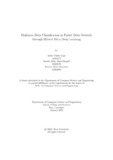| dc.contributor.advisor | Alam, Md. Golam Rabiul | |
| dc.contributor.author | Tapu, Sakib Uddin | |
| dc.contributor.author | Alam Shopnil, Samira Afrin | |
| dc.contributor.author | Tamanna, Rabeya Bosri | |
| dc.date.accessioned | 2023-08-08T05:26:35Z | |
| dc.date.available | 2023-08-08T05:26:35Z | |
| dc.date.copyright | 2023 | |
| dc.date.issued | 2023-01 | |
| dc.identifier.other | ID: 18301271 | |
| dc.identifier.other | ID: 18301076 | |
| dc.identifier.other | ID: 18301188 | |
| dc.identifier.uri | http://hdl.handle.net/10361/19352 | |
| dc.description | This thesis is submitted in partial fulfillment of the requirements for the degree of Bachelor of Science in Computer Science and Engineering, 2023. | en_US |
| dc.description | Cataloged from PDF version of thesis. | |
| dc.description | Includes bibliographical references (pages 50-52). | |
| dc.description.abstract | Advancements in wireless network technology have provided a powerful tool to boost
productivity and serve a strong communication which overcomes the limitations
of wired networks. However, because of using wireless networks, security is an
increasing concern among the community. At the time of our study, we are in the
era of 5G networks. Although we are in the 5th generation of telecommunication
we are still struggling with security. The upcoming generation, 6G, aims to solve
the security concerns by providing a secure and trust networking system. In our
study, we aim to integrate AI and more advanced infrastructure which will provide
a tremendous solution in this regard. In order to deal with this issue we primarily
aim to come up with a solution that provides a reliable intrusion detection system
in spite of being trained with a small amount of data. In our study, we aim to
integrate AI and more advanced infrastructure which will provide a tremendous
solution in this regard. Thus, we employed a trusted networking system based on
AI. Here, at first we primarily focused on Reinforcement Learning (RL) to classify
the network data coming from the untrusted packet data networks (PDN), whether
it is malicious or not. Another existing problem is people currently rely on machine
learning techniques to create a trustworthy networking system. However, it hinders
the development of getting a reliable network as the number of real publicly available
malicious data is not sufficient to train a model properly and in real life people are
not very keen to share these data as they are sensitive. Therefore, we propose a novel
idea of hybrid meta learning in the detection of malicious packet data. We use a
combination of Siamese and Prototypical network where Siamese network is used for
binary classification and Prototypical network is used for multi class classification.
As both approaches are based on meta learning techniques, it requires a very small
amount of data. By utilizing this characteristic of meta learning, we were able to
train our model with just 3000 data samples and achieve more than 90% accuracy
for both meta learning tactics. Lastly we provide a comprehensive study on the
given RL methods and hybrid meta learning and share our future thoughts. The
purpose of our study is to provide a secure and trustworthy network domain which
enhances the communication between end users. | en_US |
| dc.description.statementofresponsibility | Sakib Uddin Tapu | |
| dc.description.statementofresponsibility | Samira Afrin Alam Shopnil | |
| dc.description.statementofresponsibility | Rabeya Bosri Tamanna | |
| dc.format.extent | 52 pages | |
| dc.language.iso | en | en_US |
| dc.publisher | Brac University | en_US |
| dc.rights | Brac University theses are protected by copyright. They may be viewed from this source for any purpose, but reproduction or distribution in any format is prohibited without written permission. | |
| dc.subject | Reinforcement learning | en_US |
| dc.subject | A2C | en_US |
| dc.subject | PPO | en_US |
| dc.subject | Meta-learning | en_US |
| dc.subject | Few-shot-learning | en_US |
| dc.subject | Siamese-network | en_US |
| dc.subject | Prototypical-network | en_US |
| dc.subject | Intrusion-detection | en_US |
| dc.subject | Malicious-data-classification | en_US |
| dc.subject | CSE-CIC-IDS2017 | en_US |
| dc.subject | CSE-CIC-IDS2018 | en_US |
| dc.subject.lcsh | System safety. | |
| dc.subject.lcsh | Machine learning | |
| dc.title | Malicious data classification in packet data network through hybrid meta deep learning | en_US |
| dc.type | Thesis | en_US |
| dc.contributor.department | Department of Computer Science and Engineering, Brac University | |
| dc.description.degree | B. Computer Science and Engineering | |

